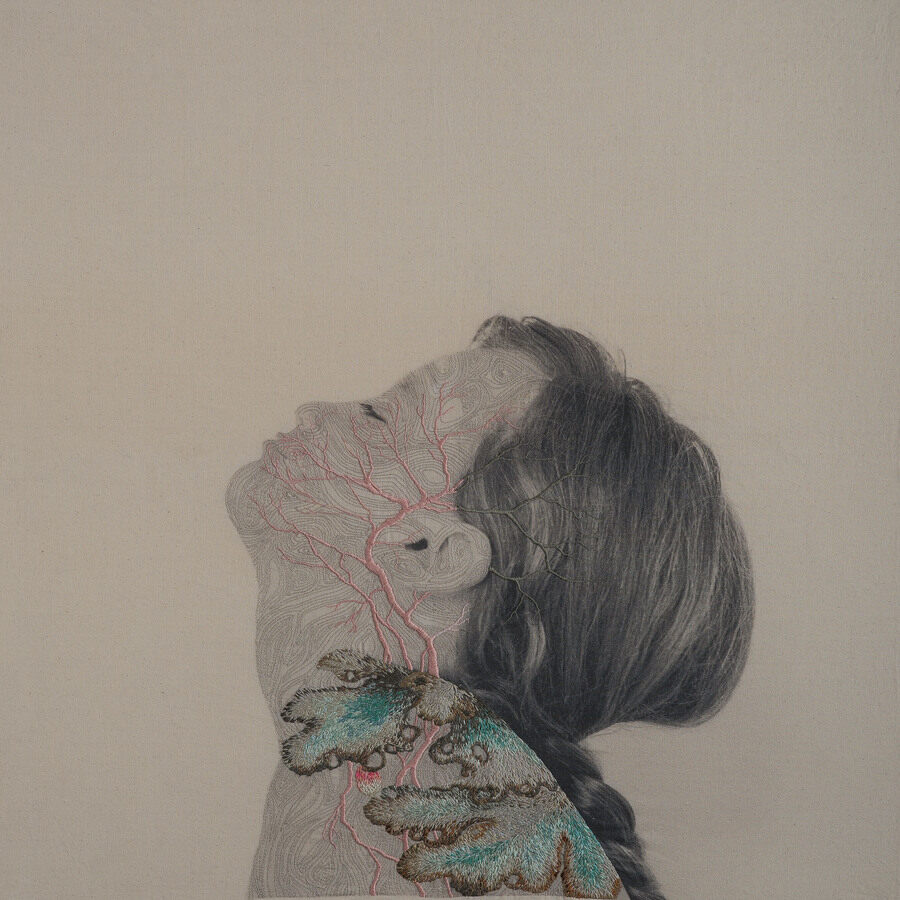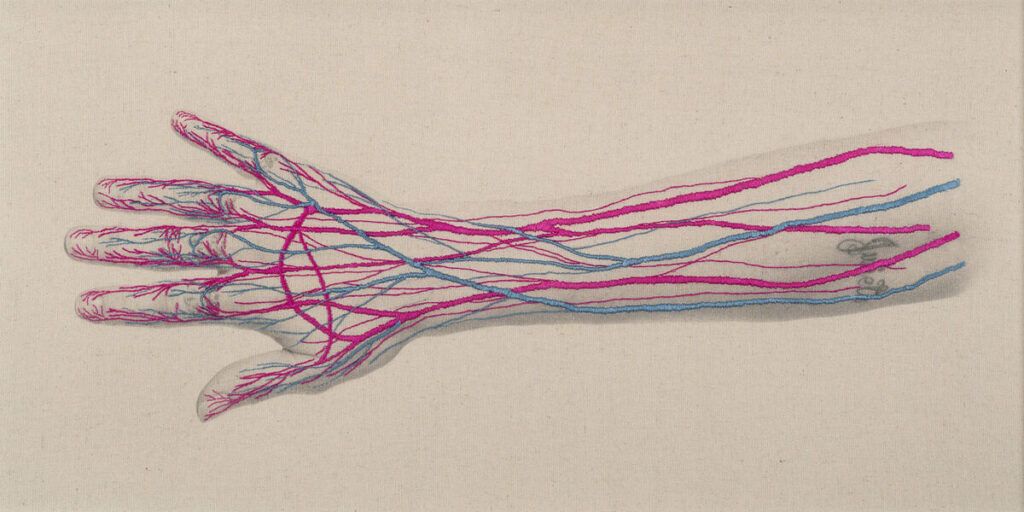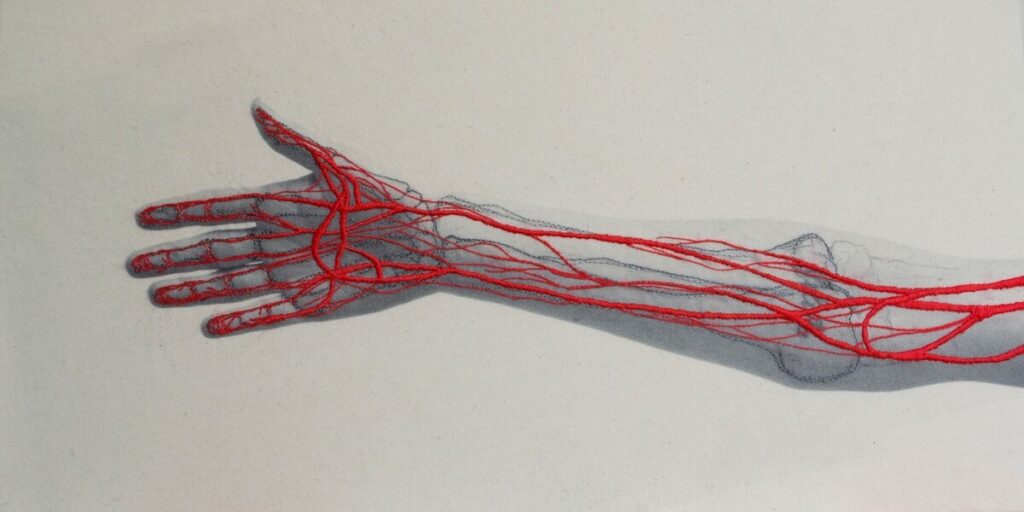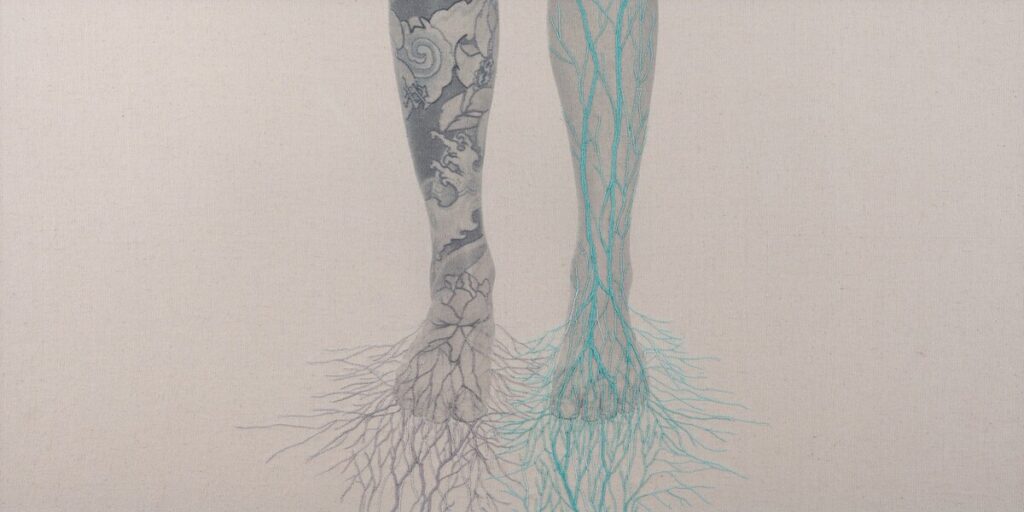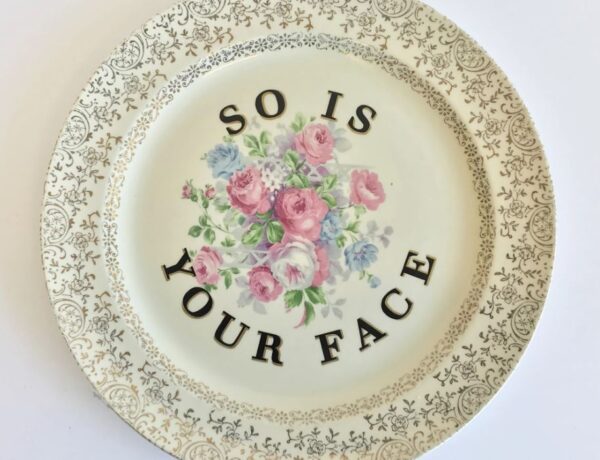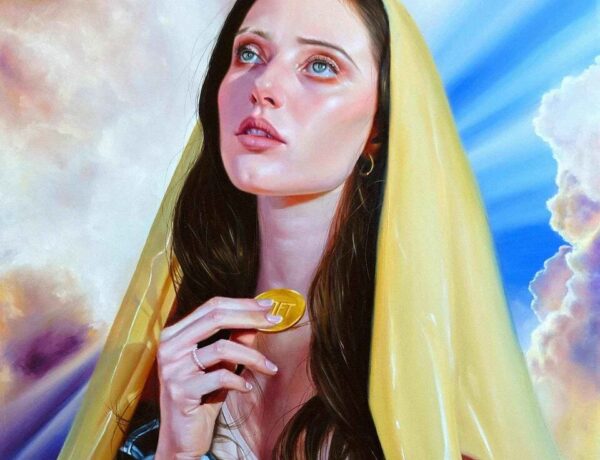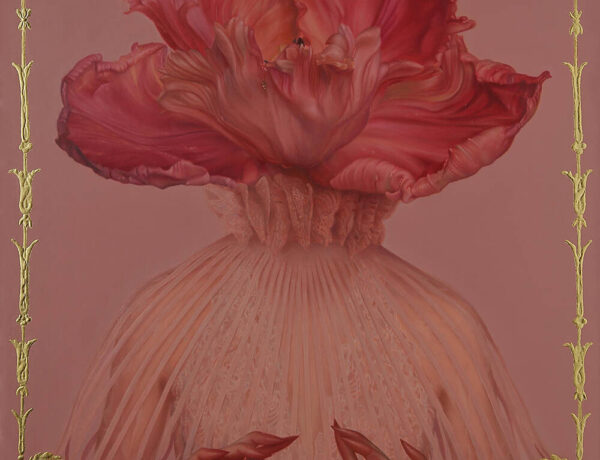Chilean artist Juana Gómez sees continuity between nature, wilderness and the human body. By bridging the gap between science and art, she weaves labyrinthine networks onto photographs. Her embroidery is subtle and traces fine lines on paper just like a pencil would.
The artist knows how to create particular embroidered effects whether it is with photographs, colours, space, or texture. There is a form of spirituality and mindfulness to her art that is both grounding and earth-shattering. Juana Gómez shares memories from her time in catholic school.
She learned embroidery the old-school way, taught by a charismatic and tender nun. “The curious thing is that there usually were nuns who instilled terror in us but not this one.”, she nostalgically recounted.
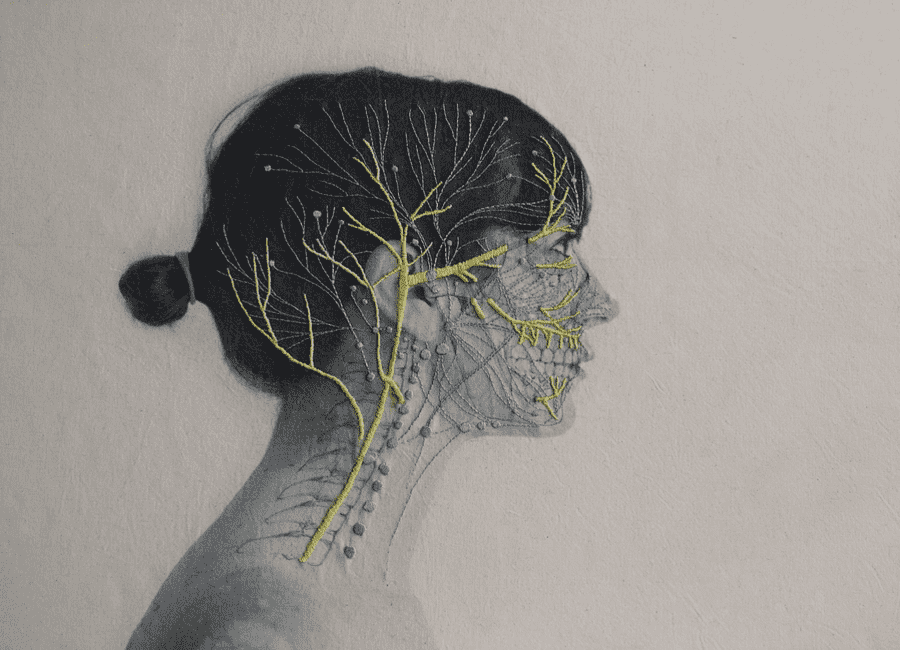
She was also taught French and the intricacies of handwritten calligraphy, but they did not fulfill her as much as embroidery did. With an experience close to the mystical and the warmth of her favorite nun’s presence, she weaved threads of compassion and care under the eyes of the Virgin Mary. The nun taught her how to draw, as well…a skill she nurtured well after she left the school. Indeed, her education played a big part in acquiring the skills she currently hones. She worked with threads until she started college and then took interest in photography and programming. Through these mediums, she started questioning what she wanted to get out of the images she saw through camera or on screen. Rather than compartmentalizing her skills and knowledge, she used them in a complementing way in order to further her exploration of image.
Technology is also a flow; it can be a flow of information, data, electricity, fuel. Technology is pipes, cables, algorithms – all this accumulation forms a structure that is not far from the logic of our own body.
Indeed, Juana Gómez shares again, “Embroidery literally gave it (the image) another dimension, another time, another materiality, another commitment.”
We can see the influence of her photography and programming background in artworks such as Transferencia, as it deals with this idea of internal connection and grounding but through a more mechanical lens. According to the artist, “Technology is also a flow; it can be a flow of information, data, electricity, fuel. Technology is pipes, cables, algorithms – all this accumulation forms a structure that is not far from the logic of our own body. Technology is an offspring of man, it is our son, therefore it is also our reflection.”
Juana Gómez’s overall artistic process is instinctual and devoid of pretension. As a result, ideas come to her in dreams or drawings and lead her to inner lands of wonder. Indeed, by comparing herself to Alice from Alice and the Wonderland, she highlights the otherworldly feel of her exploration. The idea behind this instinct-based metaphysical quest, is that we, as humans, are conditioned by the same physical laws as any other element in nature. Subsequently, intuitive creation manifests itself through the need to materialize its abstract nature and turn it into something tangible.
I draw patterns inspired by the flow of things. By “things”, I mean water, electricity, thoughts, traffic.
The body is the one who accompanies us on this crazy journey called life; each wrinkle, each gray hair is a record of your existence…the body is a portrait of time. As a woman, I try to make peace with it!
It is true that some elements in our bodies have a specific electrical charge. Our bodies, made of water or cells internally mirror the external diversity we see around us. Juana Gómez enjoys exploring this continuity between human bodies and other natural elements. When she looks at the shape of a branch, she sees a lung. Similarly, when she browses through an anatomy book, she sees roots of trees instead of veins. Moreover, the sensation of grounded-ness of both the body and natural elements seem to allow her to expand her consciousness. Most importantly, Juana Gómez through her affinity with indigenous practices in her own native Chile or Peru – the country next door – attempts to strengthen her bonds with the earth.
“In Paracas (Peru), there was a civilization that buried their dead in several bundles of textiles woven in looms and embroidery, the corpses were buried as seeds to be reborn to eternal life; it gave meaning to life and its continuity.”
Indeed, according to the artist, the bond between human and nature lies in its fundamental reciprocity. Or at least, it should. It is a relationship guided by the stream of time as it is reflected in the stars, in the moon or nature’s seasons. Indeed, Juana Gómez offers a woven cosmovision that starts with and within herself and expands to the universe.
In her 2016 project Constructal, the artist chooses to incorporate herself and her anatomy into her art. Her body seems to belong to a new sort of anatomical study. She seems to be interested in inviting spectators to dive into her core. They are like scientists inspecting the number of rings inside the trunk of a tree, in hopes of finding its age.

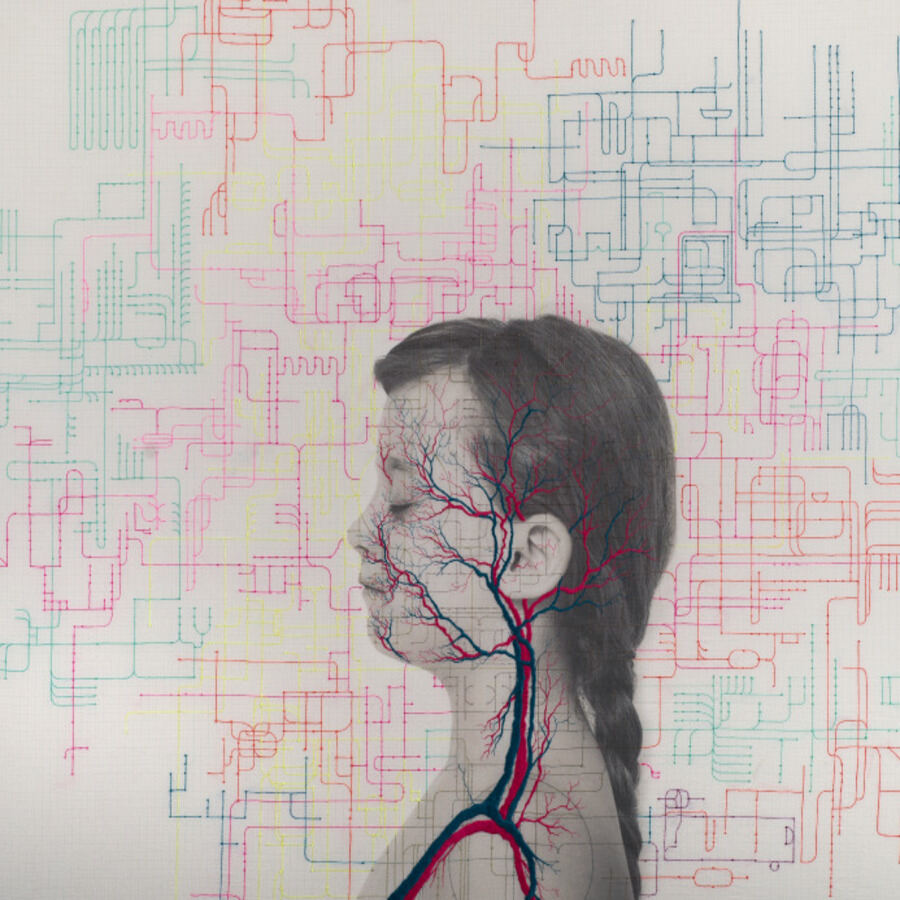
Juana Gómez explains how embroidering on a picture of her body felt like she was in some aspects covering herself and confronting her fears regarding her appearance. It is true, that showcasing some form of vulnerability is no easy task. However, as she puts it herself, “The body is the one who accompanies us on this crazy journey called life; each wrinkle, each gray hair is a record of your existence…the body is a portrait of time. As a woman, I try to make peace with it! I would love to repeat this series in my sixties or even my nineties if life allows me to!”
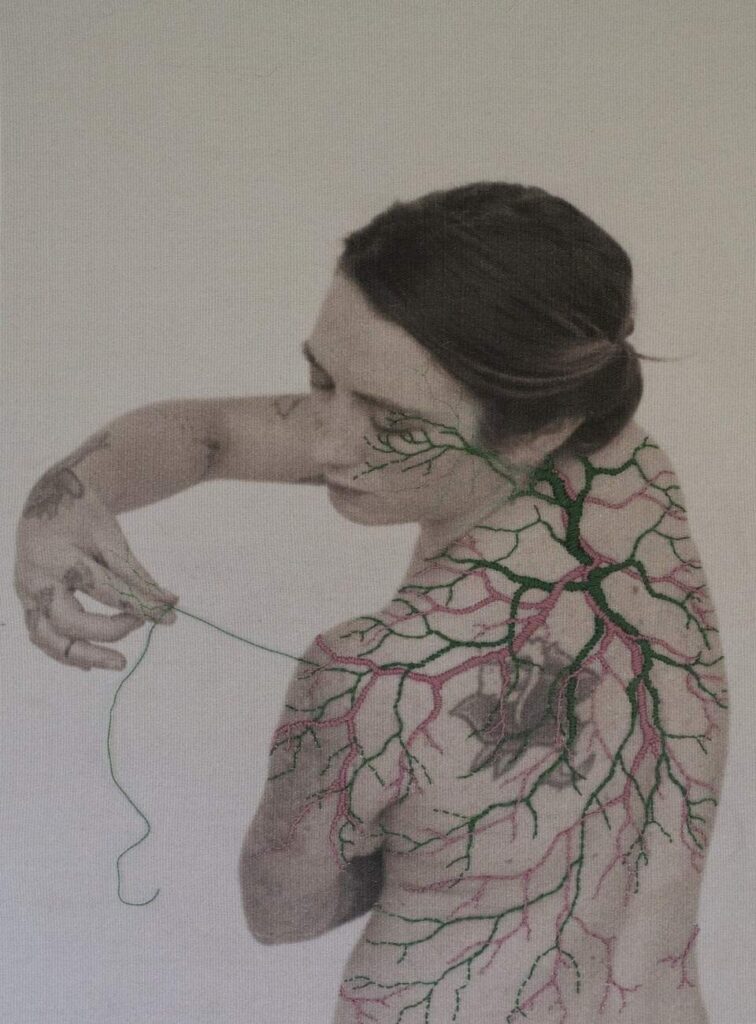
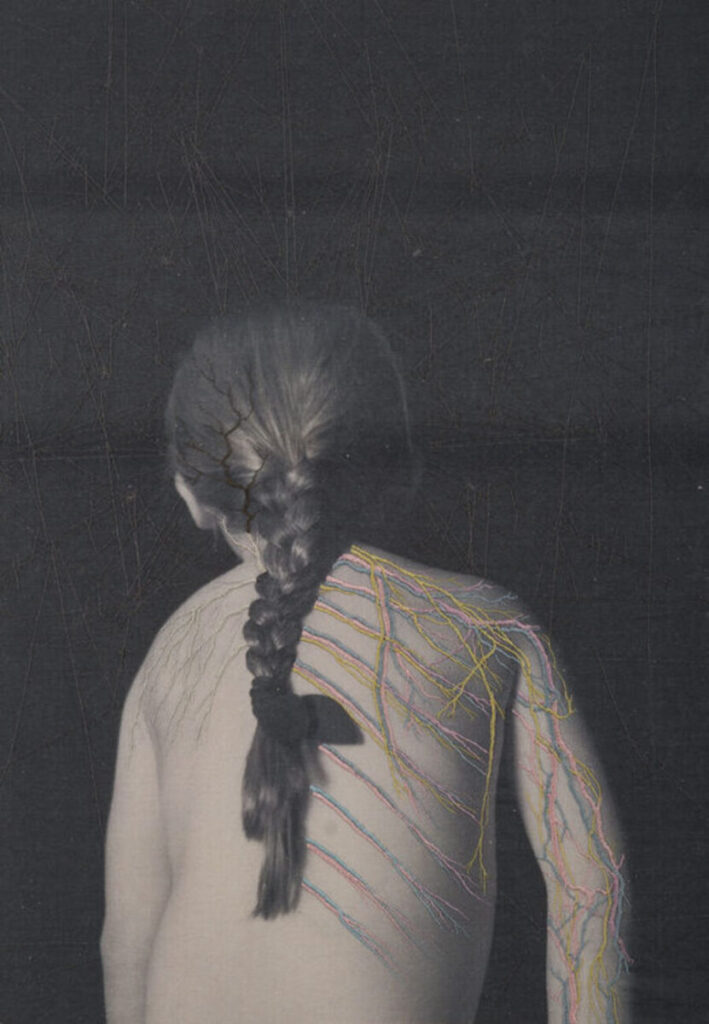
This artwork holds a special place in my heart. I worked with people who trusted me.
In Symbiosis, the artist took pictures of herself laying down naked on soil as if she was one with it. The network of veins she embroidered resembles the roots of a tree. The artist revealed that she was inspired by the American photographer Sally Mann and her Body Farm series. “I love her work in general, but that one specific series was tremendously daring.”, she shared.
On the other hand, her 2016 project Cultivo does not contain the presence of a body. The artist uses space to create a network of veins floating in the air. Her embroidery is almost abstract. Somehow both material and immaterial. Bright red threads, intertwined, serve as a metaphor to reveal the complexity of the living. When you inspect the installation a little closer, you will see invisible wires supporting these threads.
“This artwork holds a special place in my heart. I worked with people who trusted me. I am lucky to have an engineer and fisherman uncle who helped me make a perfect plot with a pencil and a ruler, at the intersections we put an eyebolt. From there, he taught me to make fishing knots and tighten the transparent thread.”
When the light touches the installation, you can see its image reflected on the walls. Indeed, its shadow itself could very well stand on its own. Or be photographed in order to leave it all up to the spectator’s imagination. The work is based on photos of neuronal cell culture from the Felipe Court laboratory in neuroscience. Juana wanted to represent axons, the cable transmission of neurons. In order to do so, she used the same pattern as the one in the Constructal series. The structure was woven according to the sections seen through microscopic photos. Above all, it was a tenuous process.
Juana Gómez has worked with several Chilean artists such as Cecilia Vicuña, Sebastián Jatz, Cecilia Avendaño and Ivan Navarro – all beloved and recognized artists with whom she collaborated in performances or in their projects. Indeed, the artist is naturally inclined to openness. She seems to be welcoming of any form of joint creative endeavor. And dare we say, this inclination to connection probably explains why she deals with it so well in her own art.



